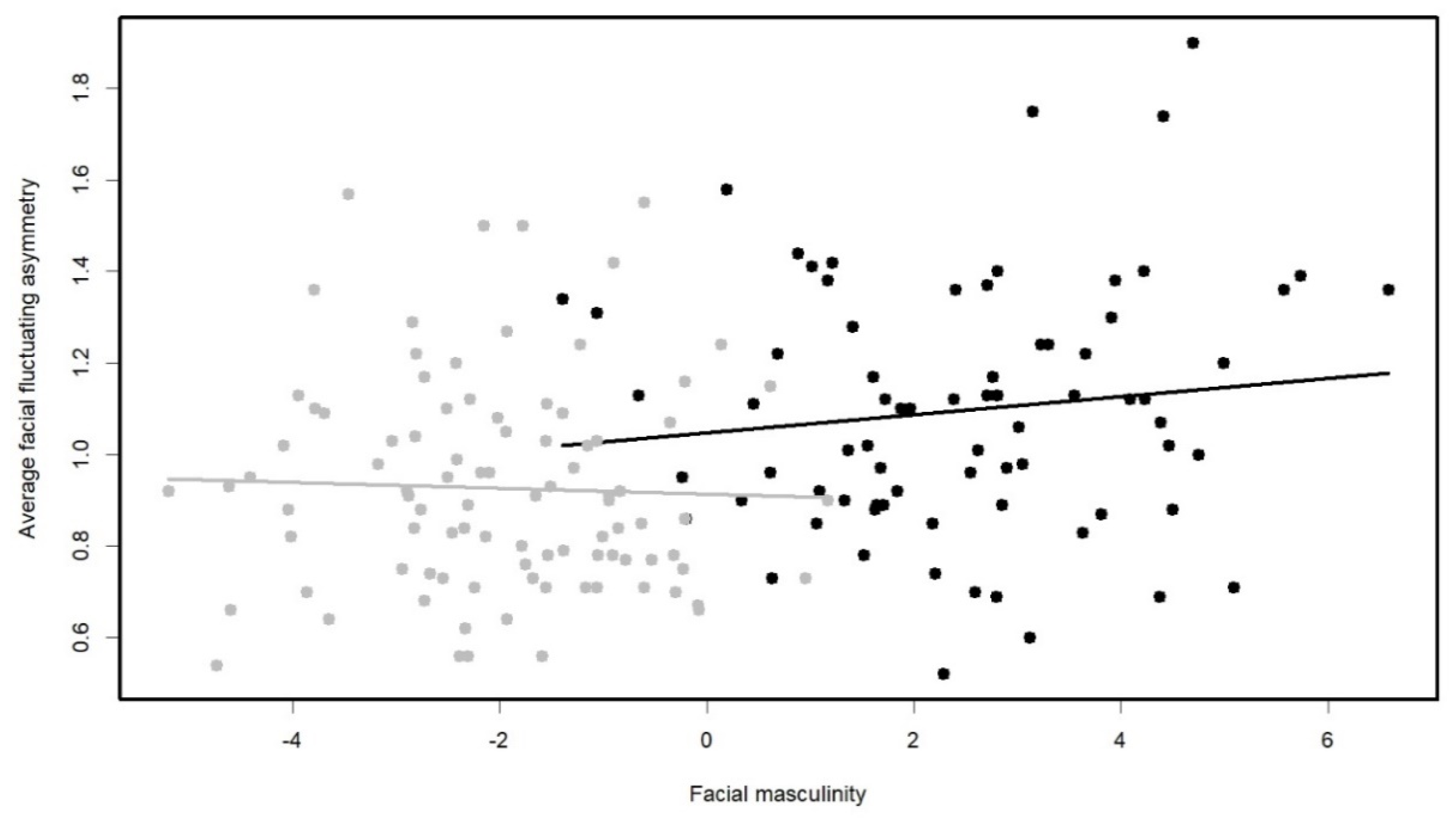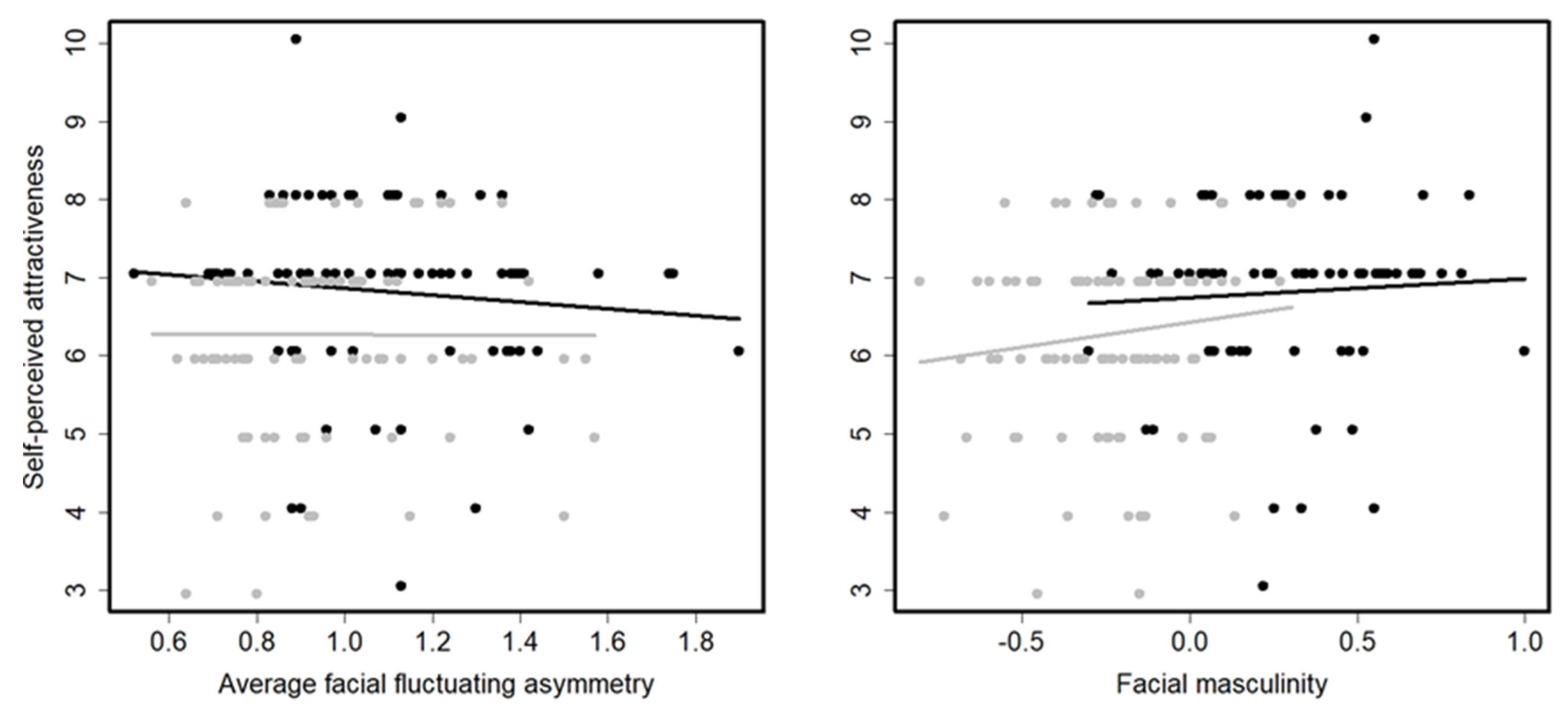Lack of Correlation between Facial Sexual Dimorphism, Fluctuating Asymmetry and Self-Perceived Attractiveness in Men and Women
Abstract
1. Introduction
2. Materials and Methods
3. Results
4. Discussion and Conclusions
Author Contributions
Funding
Conflicts of Interest
References
- Klingenberg, C.P. A Developmental Perspective on Developmental Instability: Theory, Models, and Mechanisms. In Developmental Instability: Causes and Consequences; Oxford University Press: Oxford, UK, 2007; Volume 3, pp. 154–196. [Google Scholar]
- Van Dongen, S.; Gangestad, S.W. Human fluctuating asymmetry in relation to health and quality: A meta-analysis. Evol. Hum. Behav. 2011, 32, 380–398. [Google Scholar] [CrossRef]
- Van Dongen, S. Associations between asymmetry and human attractiveness: Possible direct effects of asymmetry and signatures of publication bias. Ann. Hum. Biol. 2011, 38, 317–323. [Google Scholar] [CrossRef] [PubMed]
- Zaidi, A.A.; White, J.D.; Mattern, B.C.; Liebowitz, C.R.; Puts, D.A.; Claes, P.; Shriver, M.D. Facial Masculinity Does Not Appear to Be a Condition-Dependent Male Ornament and Does Not Reflect MHC Heterozygosity in Humans. Proc. Natl. Acad. Sci. USA 2019, 116, 1633–1638. [Google Scholar] [CrossRef] [PubMed]
- Brown, W.M.; Price, M.E.; Kang, J.S.; Pound, N.; Zhou, Y.; Yu, H. Fluctuating asymmetry and preferences for sex-typical bodily characteristics. Proc. Natl. Acad. Sci. USA 2008, 105, 12938–12943. [Google Scholar] [CrossRef] [PubMed]
- Little, A.C.; Jones, B.C.; Waitt, C.; Tiddeman, B.P.; Feinberg, D.R.; Perrett, D.I.; Apicella, C.L.; Marlowe, F.W. Symmetry is related to sexual dimorphism in faces: Data across culture and species. PLoS ONE 2008, 3, e2106. [Google Scholar] [CrossRef]
- Van Dongen, S. Fluctuating asymmetry and masculinity/femininity in humans: A meta-analysis. Arch. Sex. Behav. 2012, 41, 1453–1460. [Google Scholar] [CrossRef]
- Van Dongen, S. Lack of correlation between fluctuating asymmetry and morphological masculinity/femininity in primate skulls. Int. J. Primatol. 2015, 36, 113–123. [Google Scholar] [CrossRef]
- Whitlock, M. The heritability of fluctuating asymmetry and the genetic control of developmental stability. Proc. R. Soc. Lond. Ser. B 1996, 263, 849–854. [Google Scholar]
- Muñoz-Reyes, J.A.; Fernández, A.M.; Flores-Prado, L.; Guerra, R.; Turiégano, E. Fighting ability influences mate value in late adolescent men. Pers. Individ. Dif. 2015, 80, 46–50. [Google Scholar] [CrossRef]
- Gallup, A.C.; Fink, B. Handgrip Strength as a Darwinian Fitness Indicator in Men. Front. Psychol. 2018, 9, 439. [Google Scholar] [CrossRef] [PubMed]
- Sneade, M.; Furnham, A. Hand grip strength and self-perceptions of physical attractiveness and psychological well-being. Evol. Psychol. Sci. 2016, 2, 123–128. [Google Scholar] [CrossRef]
- Ekrami, O.; Claes, P.; White, J.D.; Zaidi, A.A.; Shriver, M.D.; Van Dongen, S. Measuring asymmetry from high-density 3D surface scans: An application to human faces. PLoS ONE 2018, 13, e0207895. [Google Scholar] [CrossRef] [PubMed]


© 2020 by the authors. Licensee MDPI, Basel, Switzerland. This article is an open access article distributed under the terms and conditions of the Creative Commons Attribution (CC BY) license (http://creativecommons.org/licenses/by/4.0/).
Share and Cite
Van Dongen, S.; Ekrami, O.; Claes, P. Lack of Correlation between Facial Sexual Dimorphism, Fluctuating Asymmetry and Self-Perceived Attractiveness in Men and Women. Symmetry 2020, 12, 236. https://doi.org/10.3390/sym12020236
Van Dongen S, Ekrami O, Claes P. Lack of Correlation between Facial Sexual Dimorphism, Fluctuating Asymmetry and Self-Perceived Attractiveness in Men and Women. Symmetry. 2020; 12(2):236. https://doi.org/10.3390/sym12020236
Chicago/Turabian StyleVan Dongen, Stefan, Omid Ekrami, and Peter Claes. 2020. "Lack of Correlation between Facial Sexual Dimorphism, Fluctuating Asymmetry and Self-Perceived Attractiveness in Men and Women" Symmetry 12, no. 2: 236. https://doi.org/10.3390/sym12020236
APA StyleVan Dongen, S., Ekrami, O., & Claes, P. (2020). Lack of Correlation between Facial Sexual Dimorphism, Fluctuating Asymmetry and Self-Perceived Attractiveness in Men and Women. Symmetry, 12(2), 236. https://doi.org/10.3390/sym12020236




